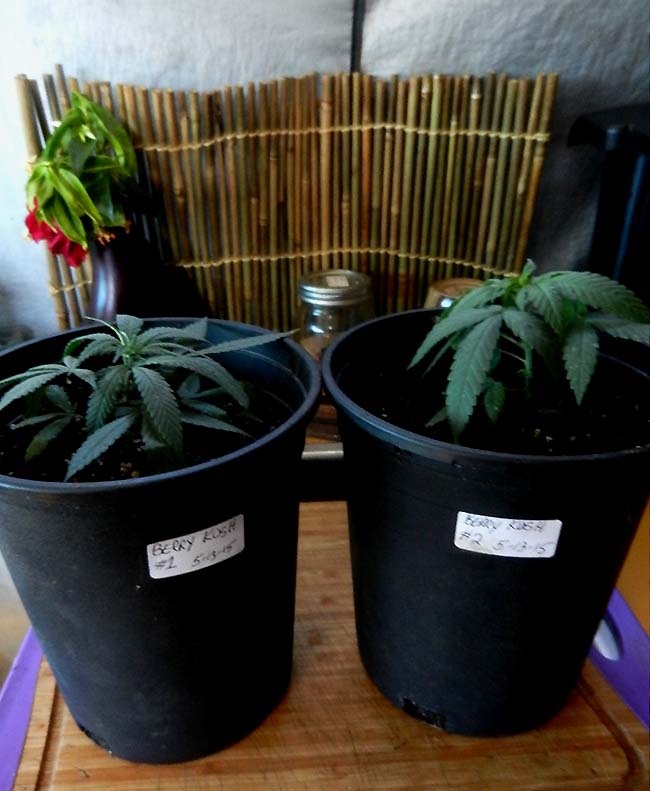July 4th: Vegetation (Week 7)

Both plants transplanted to 1 gal pots filled with 1250 grams of semi-moist Happy Frog organic potting soil.
When the current grow (#12) is harvested on 7-18 the photoperiod will be
reset to 18/6. These two plants and the Pineapple Express will be permanently
transferred to the flowering chamber and allowed to vegetate until they are
at least 12" tall. At that point the photoperiod will be shortened to 12/12
and the plants will begin to flower. In about 10-14 days the plants will
start to show their sex and the males will be discarded.
(Week 8)
Good progress this past week ... plants now 4.5" tall.
7-14: Both plants were given 1 cup of RO H
2O with
a heavy (2 tbls p/gal) of Biothrive Grow bringing their weights to 1150 grams.
7-17: Both plants were given 1 cup of RO H
2O with
a heavy (2 tbls p/gal) of Biothrive Grow bringing their weights to 1150 grams.
July 18th: Vegetation (Week 9)
I just realized that I do not need to maintain two separate chambers ...
the LED lit chamber can be left on an 18/6 photoperiod and those plants that
are ready to flower just need to be removed at 6 pm to a dark chamber until
morning to meet the required 12 hours of darkness that flowering plants need
each day.
This allows the not quite ready plants to continue their vegetation
under the best light. Seedling and clones can still be started under fluorescents
in the former vegetation chamber until they are ready to be transferred.
Now that Grow 12 has been harvested the photoperiod in the flowering chamber
was reset to 18/6 and all of the remaining plants transferred over to continue
their vegetation.
7-21: Both plants had additional soil added and were given 1 cup of RO H
2O with
a heavy (2 tbls p/gal) of Biothrive Grow bringing their weights to 1250 grams.
July 25th: Vegetation (Week 10)
The plants were topped at the uppermost
node in order to increase the number of active growing tips. They will continue
to vegetate for another 2-3 weeks or until the plants in Grows #'s 13 and
15 are also near 12" tall. At that time the photoperiod will be reset to
12 hours of darkness and all the plants will be forced into flowering
Both plants were given 1 cup of RO H
2O with
a heavy (2 tbls p/gal) of Biothrive Grow bringing their weights to 1250 grams.
7-27: Both plants were given 1 cup of RO H
2O with
a heavy (2 tbls p/gal) of Biothrive Grow bringing their weights to 1250 grams.
7-31: Both plants were given 1 cup of RO H
2O with
a heavy (2 tbls p/gal) of Biothrive Grow bringing their weights to 1200 grams.
August 1st: Vegetation Week 11
The two plants are shown here in the
rear row on the left in this 'before the lights come on' photo. Overnight
temperatures range between 65 - 75F.
8-3: Both plants were given 1 cup of plain H
2O bringing their weights to 1200 grams.
8-7: Both plants were given some additional potting soil and 1 cup of RO H
2O with
a heavy (2 tbls p/gal) of Biothrive Grow bringing their weights to 1240 grams.
August 8th: Flowering (Week 1)
In
order to force the plants into flowering they were removed to the vegetation
chamber which goes dark at 6 pm increasing the photoperiod (darkness) to
12 hours. This will be done every evening for the next two weeks or so until
they show their sex. Any males will be discarded. The remaining females will
continue to be swapped back and forth until the other plants, now vegetating
in the flowering chamber, are themselves ready to be flowered and sexed.
8-9:
The plants from Grows #13 and #14 have been in total darkness
for 36 hours as I had read that would better prepare them for the change
in photoperiod. This morning they were reintroduced to the light. Notice
how the centers of the growing tips have lightened turning yellow green and
begun to spread apart so that the future flowers can get more light.
8-10: Both plants were given 2 cups of RO H
2O with
a heavy (2 tbls p/gal) of Biothrive Bloom bringing their weights to 1350 grams.
August 15th: Flowering (Week 2)
Disappointedly both plants turned out to be male.
Here are side by side images of sexed plants ... the Berry Kush is on the
right. Notice the male plant forms clusters of these little football like
pollen sacks whereas a female plant produces yellow white thread like
pistils which emerge in pairs just above the stipules at the node where the
calyxes (ovaries) form.
My previous experience is that the process is completed in 7 -10 days and
those that were on the late end of this continuum were either male or turned
out to be hermaphrodite and later went on to produce seeds because they weren't
caught in time. Unfortunately both plants will have to be destroyed to prevent
fertilization of the other plants in the flowering chamber.
.